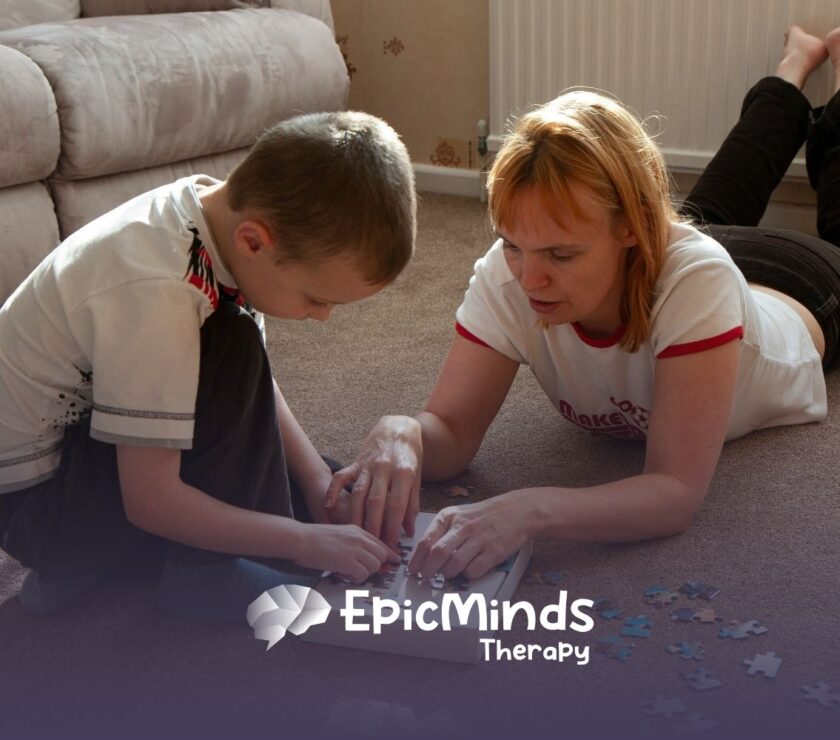Applied behavior analysis has become a cornerstone for supporting early development in children with autism spectrum disorder. ABA therapy for toddlers uses evidence-based techniques to teach communication, social interaction, daily living skills, and more. Early engagement in these interventions can set the stage for long-term progress and independence.
This article reviews key strategies in applied behavior analysis for young learners. It covers methods such as task analysis, discrete trial training, antecedent-based interventions, naturalistic teaching, functional behavior assessment, and parent-led approaches. Professionals and families in North Carolina can use these insights to collaborate effectively and support toddlers on the autism spectrum.
Understanding ABA Therapy
Definition And Goals
Applied behavior analysis (ABA) is a systematic approach that identifies how environmental factors influence behavior. It focuses on observable actions and uses reinforcement principles to increase desirable skills and decrease interfering behaviors. For toddlers, the aim is to build foundational competencies in communication, social interaction, self-care, and early academic abilities.
Evidence Basis And Age Range
Numerous studies validate ABA’s effectiveness for young children, especially when started before age four. Early intervention during this critical period can yield lasting gains in language development and adaptive behaviors, with benefits maintained up to 18 years later. Professional bodies such as the American Psychological Association recognize ABA as a safe, evidence-based practice for individuals with ASD.
Breaking Down Skills
Teaching complex abilities becomes manageable when steps are isolated and reinforced.
Task Analysis
Task analysis decomposes a routine—like dressing or brushing teeth—into discrete steps. Caregivers teach each component sequentially, ensuring mastery before moving on. This approach fosters independence by preventing overwhelm and building confidence.
Discrete Trial Training
Discrete trial training (DTT) presents skills in small, controlled trials with clear instructions, prompts, and immediate positive reinforcement. Each trial follows a consistent format—cue, response, consequence—which accelerates learning through repetition and reward.
Table 1 compares core teaching techniques:
| Technique | Focus Area | Key Feature |
| Task Analysis | Daily Routines | Breaks tasks into step-by-step instructions |
| Discrete Trial Training (DTT) | Skill Acquisition | Uses structured trials with prompts and praise |
| Antecedent-Based Intervention | Environment Setup | Modifies triggers to encourage or discourage specific behaviors |
| Naturalistic Teaching Strategies | Generalization | Embeds learning within play or daily activities |
Creating Supportive Environments
Tweaking surroundings can reduce barriers to learning and minimize problem behaviors.
Antecedent-Based Interventions
Antecedent-based interventions adjust environmental factors that might trigger unwanted behaviors. By clarifying instructions, removing distractions, or providing visual cues, toddlers can focus on the intended task. This strategy decreases frustration and increases engagement.
Structured Routines
Consistent daily schedules benefit toddlers by setting clear expectations. Predictable meal times, therapy sessions, and bedtime rituals foster security and ease transitions. Research shows that children with ASD thrive on routine, which reinforces rule-following and task completion.
Involving Parents And Caregivers
Family members play a vital role as partners in the therapy process.
Parent-Implemented Interventions
Training parents to use ABA techniques at home ensures learning extends beyond clinic sessions. Effective parent-implemented intervention teaches caregivers to break tasks into small steps, apply positive reinforcement, and track progress. Studies indicate that active parent participation leads to greater skill generalization and faster gains.
Collaborating With Therapists
Regular communication between therapists and families aligns goals and methods. Progress meetings, shared data charts, and video reviews help caregivers understand how to implement strategies correctly. This collaboration strengthens consistency and builds parents’ confidence as the child’s most important teacher.
Promoting Natural Learning
Combining structure with real-world contexts enhances skill generalization.
Naturalistic Teaching Strategies
Naturalistic teaching embeds learning within everyday activities such as snack time or play. It uses the child’s interests to motivate responses, promoting spontaneous communication and social interaction. For example, offering a preferred toy only after the child requests it verbally reinforces language in a meaningful context.
Play-Based Approaches
Play-based ABA leverages games and peer interaction to teach turn-taking, sharing, and imaginative skills. Therapists and caregivers can use structured play routines, such as “rolling a ball back and forth,” to model social cues and praise appropriate responses. This method reduces the feel of drill-and-practice and keeps sessions enjoyable.
Addressing Challenging Behaviors
Identifying triggers and reinforcing alternatives leads to lasting change.
Functional Behavior Assessment
A functional behavior assessment (FBA) identifies why a behavior occurs by examining antecedents, behavior patterns, and consequences. Therapists collect data through observation and interviews, then develop hypotheses about a behavior’s function. This process guides personalized intervention plans.
Positive Reinforcement Techniques
Positive reinforcement involves rewarding desired behaviors immediately after they occur. Rewards can be tangible (stickers, small toys) or intangible (praise, high fives). Consistent application strengthens associations between appropriate actions and positive outcomes, reducing reliance on corrective measures.
Minimizing Negative Effects
While ABA focuses on positive reinforcement, it’s important to avoid harsh procedures that can cause distress. Modern ABA aims to be child-centered and respectful, eliminating punitive techniques once common in earlier models. Sensitive implementation fosters trust and minimizes the risk of emotional harm.
Customizing Therapy Settings
Choosing the right setting aligns interventions with developmental needs.
In-Home Vs Center-Based
Toddlers up to preschool age often benefit from in-home sessions, which allow therapists to observe natural routines and coach caregivers in real time. Center-based programs, typically for older children, offer controlled environments with peer interaction and specialized equipment.
| Setting | Age Range | Advantages |
| In-Home | 2–4 years | Natural context, direct caregiver coaching |
| Center-Based | 4 years and up | Structured setting, social grouping, diverse resources |
Early Start Considerations
Initiating therapy as early as possible, ideally between ages two and three, leverages critical windows for language and social skills development. Infants at high risk for autism who receive early behavioral interventions show reduced need for intensive services by age two.
Measuring Progress And Outcomes
Ongoing data collection ensures interventions remain effective and goals stay relevant.
Data Collection And Analysis
ABA programs rely on precise data to track skill acquisition, behavior frequency, and prompt dependency. Caregivers and therapists record occurrences, durations, and contexts of target behaviors. Regular review of this data guides adjustments to intervention intensity, prompting strategies, and reinforcement schedules.
Sustaining Skills Over Time
Generalization occurs when a child performs learned skills across settings, people, and materials. To promote maintenance, therapists fade prompts gradually and practice skills in multiple environments. Periodic booster sessions help prevent regression and keep progress on track.
Considering Risks And Ethics
Awareness of controversies and ethical standards ensures respectful, effective practice.
Controversies And Criticisms
Some critics argue ABA can feel repetitive or aim for neurotypical conformity, potentially leading to emotional distress if not implemented sensitively. Historical use of punishments has given way to positive-only reinforcement in modern ABA, which emphasizes enjoyment and voluntary participation).
Ensuring Child Well-Being
Ethical ABA practice prioritizes each child’s dignity, preferences, and unique strengths. Therapists adhere to guidelines from professional bodies, obtain informed consent, and involve families in decision making. A collaborative, child-centered model reduces risk and maximizes positive outcomes.
Conclusion
Effective strategies in ABA for toddlers blend structured teaching, environmental supports, and meaningful reinforcement. Task analysis and discrete trial training lay foundational skills, while antecedent interventions and naturalistic methods promote generalization. Parent-implemented techniques and collaborative partnerships extend learning into daily life. Early intervention, sensitive application, and ongoing data review ensure interventions adapt to each child’s evolving needs.
Families and professionals can begin by setting clear, attainable goals, tracking progress through simple data charts, and integrating ABA principles into routines. By combining evidence-based methods with compassion and respect, toddlers with autism can thrive, developing communication, social, and self-care skills that pave the way for lifelong independence.
At Epic Minds Therapy, we specialize in evidence-based ABA strategies designed specifically for toddlers with autism. Our team in North Carolina combines structured teaching, naturalistic approaches, and parent collaboration to help young children build communication, social, and self-care skills that support lifelong growth. With compassionate, individualized care, we empower families to integrate ABA principles into everyday routines for meaningful progress.
Contact us today to learn how our early intervention programs in NC can help your toddler thrive and develop essential skills for a brighter future.
Frequently Asked Questions
Why is ABA therapy important for toddlers with autism?
Early ABA intervention helps toddlers build foundational skills like communication, social interaction, and self-care, setting the stage for greater independence as they grow.
What ABA strategies work best for toddlers?
Techniques like task analysis, discrete trial training, naturalistic teaching, and positive reinforcement are commonly used, adapted to meet each child’s unique needs.
Can parents be involved in their toddler’s ABA therapy?
Yes! Parent involvement is crucial. Therapists provide training and guidance so families can reinforce skills at home, ensuring consistency and faster progress.
SOURCES:
https://www.medicalnewstoday.com/articles/is-aba-therapy-harmful
https://www.autismspeaks.org/applied-behavior-analysis
https://my.clevelandclinic.org/health/treatments/25197-applied-behavior-analysis
https://raisingchildren.net.au/autism/therapies-guide/applied-behaviour-analysis-aba
https://www.chop.edu/health-resources/applied-behavior-analysis-aba-children-autism




